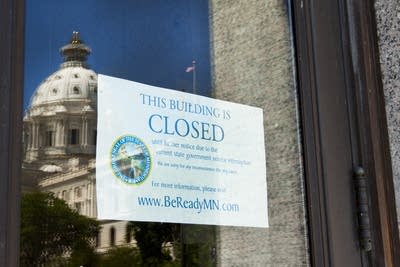Minn. shutdown costs offset by cut state worker pay, report says
Go Deeper.
Create an account or log in to save stories.
Like this?
Thanks for liking this story! We have added it to a list of your favorite stories.

Minnesota finance officials released a report Tuesday that says last summer's 20-day state government shutdown had a minimal cost to the state.
The report found that many of the costs associated with the shutdown were offset by cuts in pay to laid-off state workers.
While both Democratic Gov. Dayton and GOP legislative leaders say they want to avert future shutdowns, they're still arguing over who's to blame for the last one.
For months, state finance officials have been collecting and analyzing data that detailed the impact of the government shutdown.
Turn Up Your Support
MPR News helps you turn down the noise and build shared understanding. Turn up your support for this public resource and keep trusted journalism accessible to all.
"If you leave four out of the five pillars of the house intact, and you take out one of them, chances are the house may not completely fall as spectacularly as you expected," said Minnesota Management and Budget Commissioner Jim Schowalter. "That's really what happened with the state budget."
He said part of the reason the shutdown wasn't more catastrophic is because a Ramsey County judge ordered 80 percent of state spending to continue. But Schowalter said there was still significant harm to some groups.
"There may have been some crumbles, there may be some cracks, there may have been some very clear damages to anyone underneath that one pillar," he said. "But sizable portions of the state budget continued because of court orders."
The biggest cost to the state was $50 million in unrecoverable revenues like lost tax collections and lottery receipts, Schowalter said. He said the state also spent $10 million on shutdown preparation and recovery and another $10 million in unemployment benefits. 19,000 state workers who were laid off because of the shutdown.
But Schowalter said the state and federal governments saved $65 million in payroll during the shutdown.
Even though the savings in payroll pretty much offset the costs to the state, Schowalter said no one should consider shutting down government again. He said the shutdown did hurt Minnesota's credit rating, the state's national reputation and state workers.
Republican leaders agree. Republican Rep. Mary Liz Holberg, who chairs the powerful House Ways and Means Committee, said she wasn't surprised by the reports findings.
"It doesn't change the reality that shutdown is a bad idea. We didn't need to go there," she said. "The Legislature was more than willing to pass lights-on legislation."
That "lights-on" legislation was an attempt by GOP leadership to keep government running at reduced spending levels as the two sides negotiated a budget deal. Dayton and GOP leaders were at an impasse over how to erase a $5 billion deficit. Dayton wanted to raise income taxes on top earners. Republicans wanted to cut spending. The sides agreed to delay K-12 payments to schools and borrow against future tobacco payments.
Republican Sena. David Hann said Dayton caused the shutdown by refusing to accept the GOP budget plan.
"This shutdown exercise was unnecessary and was done purely as a political calculation on the part of the governor and designed to be inconvenient and to cause disruption to people's lives as a technique to try to gain an agreement on the budget," Hann said.
Hann, who was speaking on behalf of GOP leadership, didn't accept any blame for the shutdown. Dayton issued a statement saying Republicans were unwilling to pass a reasonable and balanced budget solution. His statement also said he's pleased the report found no net cost to taxpayers but said it showed the worst hardship fell on state workers.
Eliot Seide, with the state employee union AFSCME Council 5, agrees that state employees bore the brunt of the shutdown.
"When state employees lose $65 million, Minnesota's economy loses $65 million in consumer spending, which certainly had an impact at the time and continues to have an impact on communities that are served by public workers."
It's possible there will be another battle over the budget in the upcoming legislative session. The state will release a forecast next week that outlines Minnesota's fiscal situation.
Dear reader,
Political debates with family or friends can get heated. But what if there was a way to handle them better?
You can learn how to have civil political conversations with our new e-book!
Download our free e-book, Talking Sense: Have Hard Political Conversations, Better, and learn how to talk without the tension.





